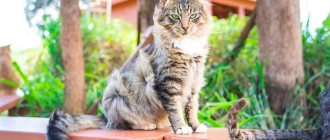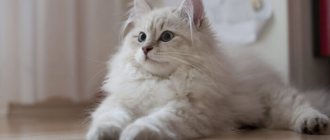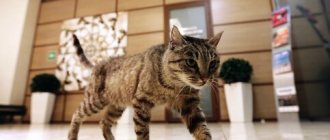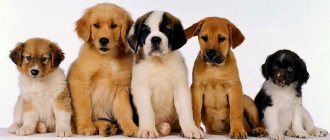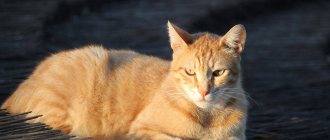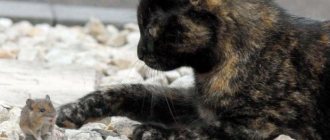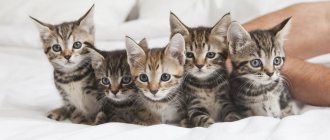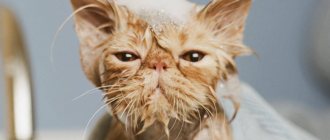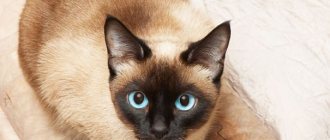Representatives of the cat family are found in the most remote corners of the planet. Among the many breeds, the group of domestic cats stands out. These are the first individuals that humans were able to domesticate.
Outbred cats combine agility, the ability to track and hunt with an affectionate nature and friendliness. The movements are silent, soft, and the weapons of attack and defense are perfectly sharpened. Pets have excellent coordination: having fallen from a great height, they always land on their paws.
Persian
The ancestors are Asian steppe and desert cats. The animal deservedly receives a gold medal from our top. Its long fur reaches 13 centimeters in length. Included with it we have a flattened muzzle, giving it a slightly harsh appearance. Because of the latter feature, many owners are forced to feed their pets by hand, since representatives of the extreme type have a nose and upper jaw set too high, making it difficult for animals to take food from a bowl on their own.
Long, thin wool requires careful grooming and combing to prevent loss of appearance and the formation of tangles. The most common colors are cream, chocolate, smoke and tortoiseshell.
Feeding
A mongrel cat is unpretentious in food. Being on the street, she quickly provides herself with food. The overwhelming majority of owners prefer to feed their pets with ready-made dry or wet food. But not every individual likes such food.
Enjoys fresh grass, fish, meat. Wild cats prefer to dine on mice, birds, insects and reptiles.
Himalayan cat
The Himalayan was developed in the United States in the 1950s by crossing a Persian and a Siamese cat. The result combines the rich fluffiness of the Persian with the coloring of the Siamese.
Genetics determines the color of a given breed. The “wild” type will have a brindle color; depending on the degree of mutation, brown (walrus) and all shades of red (from cream to bright orange) are distinguished. The paws, muzzle and tail are darker in color compared to the body.
The character also shows a mix of two leading breeds - the curiosity of the Siamese and the measured nature of the Persians. Grooming them requires daily combing of their thick coat with a special comb.
Genetics of color
The main tool for creating all shades of red is the orange gene (O). This is the only gene that is related to the sex of a cat.
A newborn Briton inherits from his parents a set of 38 chromosomes, 19 from each side. The genetic map of an animal includes all the characteristics (size, weight, height, coat length, color), as well as those that determine the sex of the baby. In cats, the combination of chromosomes looks like XX, in cats it looks like XY. The O gene attaches only to the X chromosome.
- In the dominant state, O forms a red color.
- In the recessive form, the coat tone is characterized as “not red” (in practice – black). But true charcoal color has its own B gene, which is not related to the gender of the kitten. Therefore, recessive orange was designated as “not red.” It is noteworthy that the dominant O suppresses the black color gene B. Even if one of the British parents has black hair and its trait is transferred to the baby’s genotype, the kitten will still receive a red color from the second parent.
- One X chromosome in British cats carries a single version (allele) of the O gene. In life, they can be either red (in the case of dominant O-) or not red (recessive o).
- Cats have two X chromosomes and three options for filling them: OO (red), OO (not red), OO (tortoiseshell, two-color red and black).
British boys always receive the color gene from their mother cat, regardless of paternal characteristics. That's why there are more of them. In the tortoiseshell combination of Oo alleles, sons are not born at all - the two necessary X chromosomes are missing. The only opportunity for British cats to become “turtles” is the XXY formula. But such animals always remain sterile, have no inheritance and cannot continue the color line.
The fashionable cream (peach) color is a variant of the red color. The D gene (lightener) comes into play. In the dominant form D- it leaves the coat color unchanged, and in the recessive allele dd it weakens the effect of the pheomelanin pigment. As in the main color, more peach cats are born than cats. Females are most often born not of one color, but of combined “turtles.”
The remaining genes that affect coat color in cats take part in the formation of the pattern. For example, tabby (T) forms a brindle, marbled, spotted "pattern". In red, cream or peach-colored Britons, it is always present in a dominant form, only sometimes it can be completely invisible. But stripes are traditionally observed on the muzzle, tail or ends of the paws. Although tabby is considered a fault in solid colors, it is acceptable in the case of red or cream (peach) cats.
The most valuable and complex color option for cats is solid. This group is collectively called solid and combines all homogeneous colors: black, red, blue, chocolate, lilac, cinnamon, sand and cream. Some of them (for example, chocolate or sand fawn) are prohibited for aboriginal breeds, which include British cats.
This is interesting! Feline experts fear that in the pursuit of fashionable color, the characteristic qualities of the breed may deteriorate and complex uncontrolled mutations will begin in the future. Peach color is not included in this list and is allowed not only among the British, but also in other cat groups.
Maine Coon
“Maine Raccoon” is the literal translation of this breed. It is recognized by all influential organizations and deserves “bronze” on our list.
The first Maine Coons appeared in the USA. Living in semi-wild conditions, they acquired long, warm fur coats to adapt to the harsh local climate. The raccoon coloring has survived to this day. The characteristic tassels on the ears remind of the wild past. Externally, cats look like a small lynx. By the way, they are record holders in size; there are individuals weighing up to 10 kilograms.
Top 20 cat breeds with big eyes
Big-eyed cats often have a cartoonish appearance. This trait is typical for representatives of several dozen breeds, among which there are both popular and little-known varieties.
British Shorthair
This breed of cats with big eyes was bred in the territory of modern England. It has a long and rather complicated history, and the first images of such animals date back to 700.
Britons are large cats with soft plush fur, full cheeks and huge round eyes of orange, blue or green. The coat of the breed can be painted in almost any color, including white, gray and tabby.
Big-eyed Britons are endowed not only with an interesting appearance, but also with a wonderful character. These plush cats are distinguished by their pedantic, reserved and slightly prim disposition. Big-eyed representatives of the breed are very self-sufficient, non-conflicting and full of self-esteem.
Persian cat
These furry, big-eyed animals were named after their historical homeland. Shaggy cats came to Europe about 4 centuries ago. During the existence of the breed, its representatives changed their appearance many times.
Purebred Persians are difficult to confuse with other cats. They are easy to recognize by their compact, squat body, flattened muzzle, luxurious coat of almost any color and large eyes.
Persians are affectionate and phlegmatic animals. They do not accept training and prefer to while away the time on a cozy sofa. These fluffy cats with big eyes quickly become attached to their owners and get along peacefully with other pets.
Ragdoll
These cats with big eyes appeared in America in the 60s of the last century. They were developed by crossing the Angora and Siamese. The new breed became known as the Ragdoll, which translated from English means “rag doll.” It quickly received official status and recognition from most leading felinological organizations.
The Ragdoll is a large cat with large blue eyes that can weigh up to 10 kg. Due to a special gene, his body, covered with half-length light hair, is able to completely relax in the hands of his owners.
The ragdoll's chic exterior is complemented by a wonderful character. This peace-loving, big-eyed cat quickly becomes attached to its owners and always tries to be closer to them. Due to his affectionate and gentle disposition, he cannot repel the offender. Therefore, physical punishment cannot be applied to this cat with big eyes.
Singapore
The ancestors of these big-eyed animals lived in the sewers of Singapore and would have been completely destroyed if several individuals had not been transported to America.
Thanks to the efforts of local breeders, cats were preserved and popularized. And already in 1981, Singapore had its first standard. And a few years later, big-eyed animals received recognition from many felinological associations.
The Singapore cat is small in size and weighs no more than 3 kg. Its oblong body with a long and flexible tail is covered with a short awn of brown or cream color with light markings. The Singapura's big eyes deserve special attention. They are almond-shaped and amber or greenish in color.
Singaporeans are endowed with high intelligence and active temperament. Cheerful, big-eyed cats are able to jump and play throughout the day.
Devon Rex
This distinctive breed of cats with big eyes was bred in England in the 60s of the last century. Her ancestor was an unusual female with curly hair, found on the streets of Devonshire. The very first purebred representative of the breed is a black cat named Kirli.
The Devon Rex is not large in size and weighs no more than 4.5 kg. Its stocky body with graceful limbs and an elongated head is covered with sparse wavy hair of any color.
Not only the curly fur coat, but also the expressive large eyes can be considered a unique calling card of the Devon Rex. They have a slightly slanted stance and are colored yellow, golden-green or blue.
Devon Rexes have a friendly and sociable disposition. These big-eyed cats are infinitely devoted to their owners, for which they are often compared to dogs.
Munchkin
These short-legged cats with big eyes appeared completely by accident as a result of a stable genetic mutation. Their ancestor is considered to be a black and white female named Blackberry, which means “blackberry” in English.
Due to the peculiarities of their appearance, munchkins can boast of several names at once. Because of their elongated body, the big-eyed animals were dubbed dachshund cats. And due to the habit of standing on their hind legs, representatives of the breed received the nickname kangaroo cat.
The Munchkin is a strongly built, squat animal with large eyes and a thick, not too long tail. It weighs no more than 5 kg and has short or long hair, the color of which does not necessarily have to be in harmony with the shade of the iris.
Munchkins are known not only for their interesting appearance, but also for their positive character. These big-eyed representatives of the cat family are endowed with a self-sufficient, unobtrusive disposition and high intelligence.
Scottish fold
The Scottish Fold was bred in the 60s of the last century. British shorthaired and outbred individuals with curved ears took part in the formation of unusual big-eyed animals.
Scottish Folds are cute cats with deep, expressive eyes and small ears, the tips of which are pressed tightly to the round head. The color of their beautiful large eyes strictly depends on the color of their coat. For example, black Scottish Folds have an orange iris, while Harlequins have a tea-colored iris.
In addition to their attractive appearance, Scottish Folds are endowed with a pleasant character. These big-eyed cats are distinguished by their affectionate, friendly disposition and excellent mental abilities.
Exotic
This bug-eyed, flat-faced cat is related to the Persians. It was bred by breeders from the USA, who hoped to expand the color palette of the American Shorthair breed. But contrary to their expectations, non-furry kittens with the appearance of Persians were born.
Exotics are compact snub-nosed cats with plush fur, an expressive forehead and wide-set large eyes. In appearance, they more closely resemble not a living creature, but a soft toy. The most popular representative of the breed was a Chinese cat named Snoopy. He managed to acquire an army of subscribers eagerly awaiting new photos of their favorite.
Exotics are cute cats with big eyes and a touching expression on their faces. They are endowed with a sociable, non-conflict disposition, a lively mind and natural curiosity.
Abyssinian cat
These slender, graceful animals with a long tail and ticked color are distinguished by extraordinary grace and aristocracy. Their short coat can be red, blue or copper in color. And expressive large eyes should be in harmony with the color of the coat.
Abyssinians are endowed with a sociable and playful disposition. These graceful cats with big eyes get along well with other pets and have virtually no behavioral problems. Clean and intelligent Abyssinians are easy to train and easily understand what is required of them.
Japanese Bobtail
This Japanese cat breed with large eyes and a short tail is extremely rare outside of its historical homeland. Its representatives are distinguished by a harmonious build and have a compact wedge-shaped head.
The body of Japanese Bobtails is covered with white hair with black or tan markings on the back and sides. The irises of these big-eyed cats can be blue, green or yellow.
Japanese Bobtails are sociable animals that love to spend time with their owners. These short-tailed cats with large eyes are considered excellent mousecatchers. They are very curious and actively interested in everything that happens around them.
Ukrainian Levkoy
This unusual breed of big-eyed cats was bred quite recently. Its representatives resemble sphinxes in appearance, but have soft cartilage at the tips of their ears. On the elongated triangular head of the Ukrainian Levkoy, large almond-shaped eyes with a sad and intelligent look stand out.
These graceful hairless animals quickly become attached to their owners and need constant communication with people. Big-eyed lefties are moderately cheerful, unforgiving and playful.
Burmese cat
This breed has a long history and Asian roots. Big-eyed Burmese cats are easily recognized by their small, strong body covered with short hair, neat round head and penetrating gaze. The iris color varies from dark amber to bright yellow.
Scottish Straight
These big-eyed cats are very similar to the British. They have a graceful build and weigh between 3.5-5 kg. Scottish Straights can have either short or long hair. Both varieties have developed undercoat. But the real decoration of cats of this breed are their large round eyes, the shade of which depends on the color of the coat.
Turkish Angora
The big-eyed representatives of this breed have soft, fluffy, snow-white fur. Their magnificent coat harmonizes perfectly with the iris of tea, orange, green or blue.
Unlike many other breeds, Turkish Angoras are characterized by heterochromia. And individuals with blue eyes often turn out to be deaf.
Maine Coon
These huge shaggy cats with tufts on their ears have not only an interesting appearance and a wonderful character. They are also distinguished by the expressive look of their large round eyes, the color of which can be rich yellow or green.
Canadian Sphynx
These hairless cats with huge ears look like aliens. And high, well-defined cheekbones and bottomless large eyes only enhance the resemblance to alien creatures.
Oriental cat
Representatives of this breed are close relatives of the Siamese. They attract the eye with their exquisite, sophisticated silhouette, huge ears that look like fans, and large eyes of a rich emerald hue.
Siamese cat
These graceful natives of Thailand have a long history, but in Europe they learned about them only in the 19th century. They are distinguished by a graceful physique, large eyes and a characteristic color-point color.
Cornish Rex
These big-eyed cats have an extravagant appearance. Unlike representatives of many other breeds, they do not have the usual awn. The traditional coat is replaced by a wavy undercoat, which, along with large ears and large eyes, is considered a unique calling card of the Cornish Rex.
Burmese cat
The history of these big-eyed animals began in Southeast Asia. In ancient times, Burma was considered sacred and was believed to be the reincarnation of Buddhist monks.
Norwegian forest
Norway, the birthplace of the breed, is characterized by cold frosty winters, so the fur of representatives of the Norwegian forest beauties is very thick, long and fluffy. There is a “collar” and “pants” that serve as additional protection from the cold. Even the inside of their protruding ears is covered with fur. The color of the fur coat can be very varied (white, gray, blue, black) and always harmonizes with the shade of the eyes.
Cats have a dense build and a rich, bushy tail proportional to their body length.
Siberian cat
A typical Siberian with a fluffy, warm fur coat that can keep you warm on the coldest winter day. The ancestors of the breed were Bukhara cats, brought by Asian traders. The Bukharans mixed with taiga cats and acquired long, warm hair, gradually spreading with merchants throughout the country. This is a very popular breed; it was Siberian cats that became the prototype of cats in the folk epic.
In winter, the fur of Siberian cats becomes thicker, “panties” and a “collar” appear, and by spring shedding occurs.
Siberian cats are varied in color, they can be white, silver chinchilla, all shades of reddish-red, cream, blue, brindle, tricolor.
Neva Masquerade
This breed is often considered a variety of the Siberian cat, however, in 1992 it was recognized as an independent cat. In fact, she shares 5th and 6th place with the ancestor of the suit close to her.
The color of these fluffy beauties contains the Siamese cat gene, which gives them a characteristic silver-blue color. However, variations of black-brown and orange-white are possible. The most interesting thing is that the body is always a lighter shade, while the muzzle, ears, tail and paws are in darker contrast. It looks elegant. Hence the name.
The thick, dense coat changes twice a year. The mustachioed pet has massive fluffy paws and a luxurious bushy tail.
American Curl
The history of this breed begins with a strange stray cat with characteristic crescent-shaped, backward-curved ears. The first litter of kittens from this mother was obtained in California. It is characteristic that when mating with other breeds, among the newborns there are always “eared” individuals. This feature of the breed should be taken into account when stroking the animal’s head; this should be done carefully so as not to damage the fragile ear cartilage.
Curls have a dense, thick, silky coat that requires moderate grooming. The color can be very varied. At the same time, kittens are born snow-white, only acquiring color with age.
Breeds not included in the top ten most famous
Some of the cutest cats with big eyes come from random mutations and selection. An expressive look can be found in many representatives of the cat breed, but few have truly huge eyes.
Dog with blue eyes: beautiful breeds
One of the most popular cats, not included in the top ten famous ones, is Cobby the British shorthaired chinchilla. All representatives of this variety have a bluish-gray coat color, and Cobby has a snow-white coat, perfectly combined with huge sky-blue eyes. They are incredibly expressive thanks to the black edging.
The next representative, often compared to the Cheshire cat, is Gimo. This is a cute cat with huge golden eyes.
Snoopy the cat is a short-haired exotic cat with huge eyes. He has an innocent, wise look, which contains natural charm.
Note! Due to the huge visual organ, these animals have a visual angle of 170-185 degrees. For representatives of the cat breed with normal eyes, this angle is 160-169 degrees.
Snoopy the Cat
Turkish Angora
Owners of a bushy tail and no less luxurious fur. Not very large, reaching 2.5 kg in weight. Clean and without a dense undercoat, despite their long hair, they are easier to care for than, for example, Persians. Many owners note the love of these cats for water procedures.
There are a wide variety of colors from cream, charcoal, blue and white to the more interesting merle, brindle and different variations of tabby.
This breed is distinguished by unusual eye pigmentation; in addition to the standard green, heterochromes and blue eyes are often found.
Siamese fluffy breed
It has no undercoat, so caring for it is somewhat easier. The animal has a slender, graceful body and a wedge-shaped head. The cat's eyes are almond-shaped with a very interesting color - azure, blue. The tail is long, decorated with long silky fur. Weight – up to 5 kg, life expectancy – 12 years. The creatures are incredibly affectionate in nature, sociable and easily find contact with other animals.
Burmilla longhair
These voluminous fluffy balls with huge eyes will charm anyone. The line was officially recognized by breeders in 1993, first obtained several years earlier in Australia.
Cats have shiny, silky and very fluffy fur. Their thin hairs and silvery undercoat harmoniously form a real fur cocoon, giving incredible cuteness to these four-legged animals. The fur comes in a variety of shades. The most popular are smoky, brown and lilac, cream, black tortoiseshell, Bombay and brindle.
In addition to their pleasant external characteristics, Burmillas are distinguished by their “golden” character, they are not intrusive, get along well with other pets, are affectionate and touching, and enjoy being handled.
Buying a kitten
There is probably no more charming creature in the world than a small fluffy kitten - a gentle and touching bundle of soft, warm fur. However, all children tend to grow up quite quickly, and problems that at first might seem completely insignificant to you grow with them. A few tips to help you make the right choice:
- Do not be led by your emotions - do not buy a kitten spontaneously, succumbing to a completely understandable feeling of tenderness at the wonderful baby - you are not buying a soft toy, but a living creature that has its own character and its own needs.
The little fluffy ball will grow up soon, so it’s important to base your choice of a kitten on more than just cuteness
- You will need to take care of the kitten, educate, adapt, tolerate its pranks - it is quite possible that some problems associated with the new family member will not suit your family - be sure to consult with them and make only a collective decision.
- Try to learn as much as possible about the breed you like, prepare for the arrival of a kitten in your home, both theoretically and practically - purchase in advance everything you need for feeding, rest, hygiene and leisure for your baby.
How to choose
You need to decide in a timely manner not only about the breed, but also about the purpose of acquisition. Do you want a boy or a girl? Pet or show-class animal? The criteria for choosing a little furry will largely depend on your ambitions and financial capabilities.
But the main selection criterion always remains the same - you need to purchase a healthy animal with good heredity. It is clear that no one can give one hundred percent guarantees on these issues in advance, but buying a baby not on the market, but in a professional breeding nursery, still significantly reduces many risks. In addition, a responsible breeder will forever remain your friend and first mate.
Don't try to buy a kitten that is too small; The optimal age for moving him to a new home is 2.5–3 months, when the necessary vaccinations have already been completed and independent living skills have been acquired. If possible, look at the conditions in which your baby grew up, observe the habits and habits of his parents, brothers and sisters.
After two months, vaccinated kittens can move to a new place
The baby will get used to the new place quite quickly, and from the second or third day he will need to be taught the rules of life that you consider necessary. The sooner he learns them, the more positive and pleasant moments will appear in your life together.
Find mutual understanding with your baby as soon as possible
Video: fluffy kittens - all good
Kimra cat
Cymriks are distinguished by a large massive body with a large head. The highlight is also the expressive large eyes from yellow-green to light blue.
Their thick, rabbit-like fur requires delicate care. By following it, you will get a beautiful, healthy pet of a wide variety of colors. There are individuals from white with colored splashes to tabby or calorpoint. A piquant feature is the absence of a tail in Cymrics. This is an artificially bred feature.
These friendly, calm cats get along easily with children, are peaceful and moderately active.
Health
Outbred animals rarely suffer from any diseases.
Nature has endowed them with excellent health. This distinguishes them from purebred cats, which, in turn, cannot boast of endurance or good health. If a person picks up a cat or kitten on the street, it is important to contact a veterinarian. This is the only way to be sure of the absence of diseases, parasites, and viruses. The selected animal will thank its new owner as much as possible.
Ragdoll
The name of the breed translates as “rag doll”. The ancestors were a white long-haired cat and a Burmese cat. Artificially selected, they are absolutely devoid of the instinct of self-preservation and require special care and a lot of attention. They are calm and pliable, thanks to their specific muscle tone, and sometimes seem like toys.
This fluffy treasure has soft, thick fur, a thick bushy tail and a “collar”, the animal sheds little. But he has a thirst for research and an easy-going character.
British Longhair
Recognized by the International Cat Federation (FIFe). Long silky hair, a charming face and a calm, easy-going disposition are the main characteristics of this British breed.
Cats have short, dense legs and small, widely spaced, rounded ears. The irises of large, attentive eyes can be copper, amber, blue or even orange, depending on the color of the coat. The latter is also very diverse: smoky, tabby, bicolor, tortoiseshell, color point.
Despite their long hair, the British are not prone to tangles, unlike, for example, the Persians. Once you have representatives of this breed, you will be able to enjoy your pet fluffy without much effort.
Features of care
Fluffy cat breeds require careful attention to their fur. Therefore, when buying a furry pet, you need to be prepared for the fact that you will have to devote quite a lot of time to caring for it.
The animal will have to be combed regularly using a special brush. This simple procedure not only prevents the wool from tangling and the formation of tangles, but also improves the quality of the fur coat. The regularity of brushing is determined individually. It is important to take into account the general condition and structure of the coat, as well as the living conditions of the cat.
It is recommended to bathe the animal as soon as it gets dirty. Moreover, it is better to do this using special shampoos. It is important to ensure that water does not get into the cat’s eyes and ears during the procedure. And after bathing, the foam product must be washed off with clean warm water, and the wet fur is blotted with a terry towel and dried completely.
Nibelung
The long-haired version of the Russian Blue cat is considered quite rare among breeders. Translated from German, the name means “creation of fog.” Indeed, the fur of these magnificent creatures is like a fabulous blue mist. It is believed that the main color is blue, but the tips of the hairs are white. In sunlight it creates a stunning shine effect.
Nibelugas are large cats with a strong, muscular body. The body is covered with thick undercoat, which adds additional volume to the size of the cat. To keep the coat in good condition, it is necessary to comb it at least twice a week.
Balinese cat
Balinese have a dense, medium-length coat, which may visually appear shorter than it actually is. Their fluffiest tail is their large, luxurious tail, which is why they make it into our top. The length of the hairline here reaches 7 centimeters. The animal requires proper care, as it requires frequent brushing. Without it, the undercoat gets tangled easily. Another feature of the species is congenital strabismus.
The breed was named after the Balinese dancers, because these beauties are not inferior to them in grace, elegance and flexibility.
The color shows the influence of Siamese ancestors, the eyes are sky blue.
Reviews
This is not the entire list of fluffy cat breeds. Therefore, this rating can be considered conditional. It included the most popular shaggy beauties who deserve the highest praise.
According to people in whose houses representatives of the breeds we mentioned live, they all have their own advantages, giving them the right to be called the best. Caring for animals is a certain difficulty, especially during the molting period - not everyone has the time or desire to collect wool around the house. But this is perhaps the only negative. Otherwise, all the listed beauties and beauties delight their owners and evoke a sea of positive emotions.
Oriental Longhair
Native to North America, this breed is a mix of Siamese and Shorthair.
Most often it has solid, tabby and smoky colors. Color is the main distinguishing factor from the Balinese cat.
Representatives of long-haired Orientals have a friendly and easy-going character, however, like any pet with long hair, they require special care. It is believed that these cats easily and firmly become attached to their owners, remember this when getting a kitten of this breed.
Strong build, soft fluffy fur combined with grace and dexterity.
1st place. Persian cat
The history of the origin of these furry beauties still remains unexplored. According to one version, similar animals were brought to Italy from Persia back in the 17th century, and local breeders began to work hard to improve their appearance. According to another theory, they originated from Asian domestic cats and manul cats. It is believed that it was from the latter that they inherited their natural slowness, flat muzzle and luxurious fur coat.
Persians, who top the list of gorgeous cats, have a memorable appearance. They are easily recognized by their large flat-faced head, expressive round eyes, full cheeks and upturned nose. The stocky body with a wide chest and strong back is covered with luxurious thick hair, the length of which can reach 15 cm. As for the color, it can be almost any. The most common species are red, white, cream, lilac, chocolate, blue and black.
Persians are not just one of the fluffiest cats in the world. In addition to their chic silky coat and exotic appearance, they are endowed with a wonderful character. These are very calm, good-natured and balanced animals. They are very patient, affectionate and obedient, which is why they are often kept as pets.
Ragamuffin
These cats will not leave anyone indifferent! A magnificent large cat with large expressive eyes. You just want to hug her fluffy body.
A wide variety of colors from white and black to striped, brindle and tortoiseshell, as well as interesting patterns on the coat make this breed very popular!
Ragamuffins have a rabbit-like feel and require a lot of attention and care.
Appearance
The smoky cat has an unusual appearance and is one of the short-haired felines. This cat cannot be called not beautiful, and now you will understand why. All representatives of this species are small in stature, however, they cannot be called small. Their body is medium in size with fairly well-developed muscles, which is clearly visible when the cat moves. The chest and shoulders also stand out well.
The large head is attached to the body with a medium-length neck. The muzzle is small and obtuse. The eyes are also medium in size. Their colors vary from yellow to green. The mustache is also small. The nose is medium with a noticeably prominent hollow. The ears are proportional to the head, stand erect, and their tops are rounded.
The tail is also of medium size in length and thickness. It is noteworthy that the tip of the tail is elegantly rounded. The stockiness of the animal is given by its medium-length, well-developed legs ending in small, soft oval paws. The toes are always tightly closed. The entire body of the animal is covered with uniform dark fur, which to the touch is similar to mink fur.
Napoleon
In essence, this is an offshoot of the Munchkin breed, their close, but much more miniature and fluffy creatures.
These cats are among the most expensive due to the unique small size and fluffiness of the Persians (crosses with which were carried out during the breeding of the line). Their front legs are shorter than their hind legs, and their short ears end with sharp tips.
These babies are distinguished by their gentle and devoted character.
Laperm
The Rex breed can boast of long hair and the presence of a fluffy “curly coat”. During their life, they completely change their woolen outfit several times. They often look a little disheveled, often have a pronounced “collar”, the coat is elastic, loose and very light. If you blow on it, it is easy to expose an area of the body.
Individuals are medium to large in size, their beautiful almond-shaped eyes widen when they sense danger. Cats have a funny tail that resembles a bottle brush.
Officially recognized breeds of fluffy cats WCF – 1st and 2nd group
The Burmilla Longhair is a breed descended from the Persian and the standard Burmilla. The cats have the original chinchilla color and long hair. A kind, attentive, independent cat, loyal to all living things. Moderately sociable, preferring the “company” of toys or quiet observation of others.
The Munchkin Longhair (CFA recognized) is an unusual cat with short front legs and a habit of sitting in a marmot position. The breed has a friendly and sociable character, but can fight back if necessary.
Ural Rex (long-haired)
This breed has been around for many years, but it is not as popular as, say, the Siberian. The first kitten with unusual curly hair appeared in a village in the Sverdlovsk region in 1988, three years later they were officially described by Russian felinologists.
They are a well-built, sturdy, medium-sized cat, they look less fluffy than many other breeds, but boast cute curls that give them a voluminous and original appearance. There is also a peculiar mane. Almost all colors are recognized, with the exception of cinnamon and chocolate.
